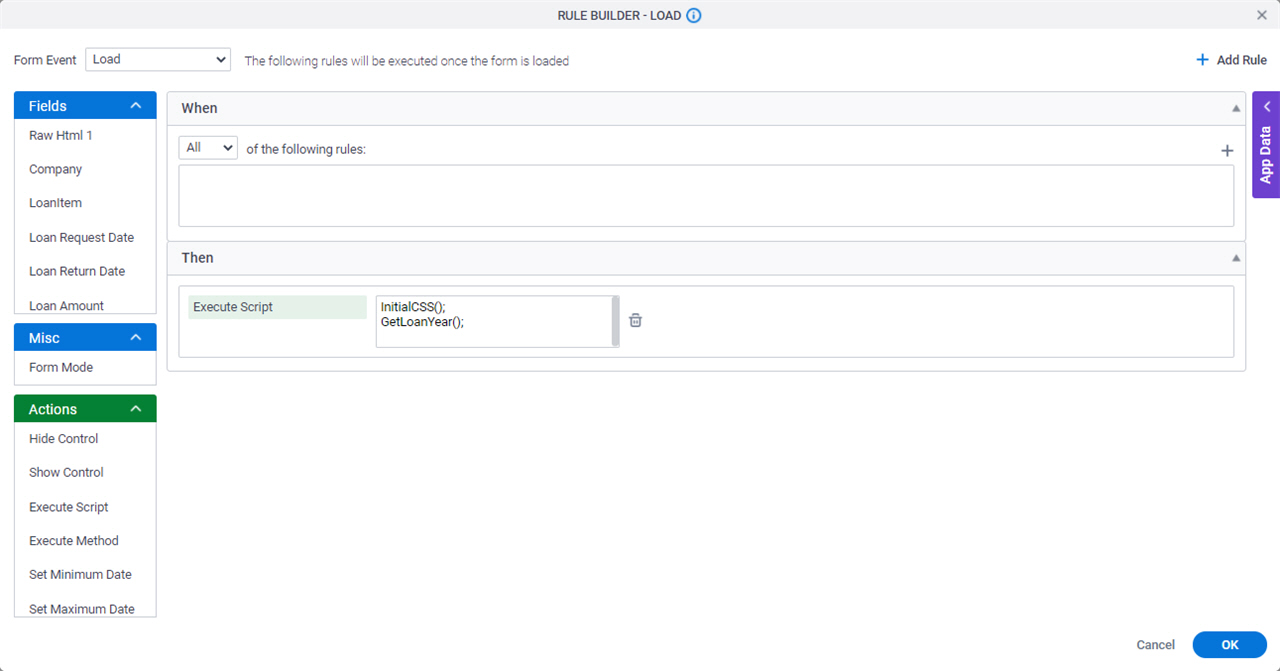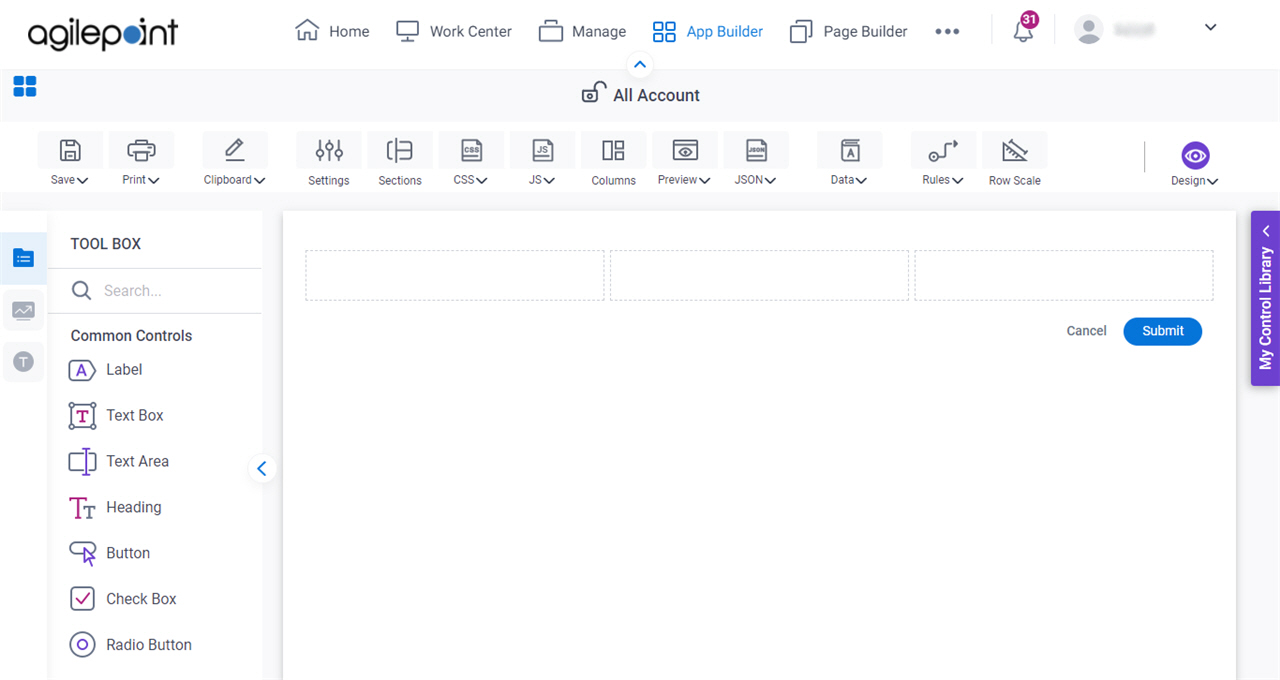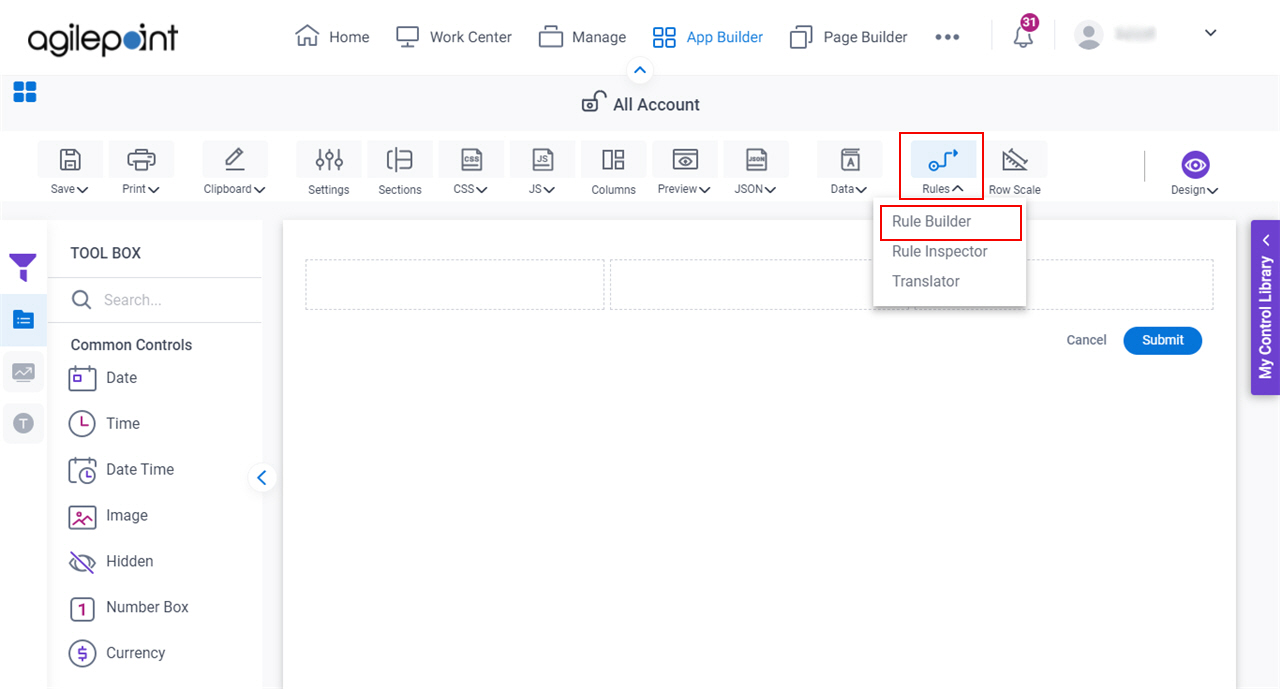Configure Rules for an eForm
To configure rules for an eForm, do the procedure in this topic.

Video: Form Designer Overview
Video: eForm Builder Interface
Examples
- (Example) Use Rules in a Form Control
- Advanced Examples
For more advanced or complex examples or specific information about how to solve a specific business problem or use case, AgilePoint recommends the following resources:
- AgilePoint Community Forums - A free, AgilePoint-moderated, crowd-sourcing user forum where you can ask questions about specific techniques, the solutions to use cases, workarounds, or other topics that may not be covered in the Product Documentation.
- Video Portal - Video walkthroughs for a range of simple and advanced tasks in AgilePoint NX.
- Professional Services - If you can not find the information you need for your specific business problem, mentoring is available through AgilePoint Professional Services.
- Personalized Training - AgilePoint can provide personalized training for your organization. To request personalized training, contact AgilePoint Sales.
Good to Know
- Rules have 2 main parts:
- Condition - The circumstances that trigger the rule. The When section of a rule specifies the conditions. Conditions have 3 parts:
- Fields - One or more form controls that trigger or give the context for the condition.
- Comparer - The operator to used to compare the two input values.
- Rule Value - The value or variable that specifies the context for the rules.
- Action - The results that occur if the conditions for the rule are true. The Then section of a rule specifies the actions.
- Condition - The circumstances that trigger the rule. The When section of a rule specifies the conditions. Conditions have 3 parts:
- In most text fields, you can use process data variables as an alternative to literal data values.
- To create rules that apply to a form control, refer to (Example) Use Rules in a Form Control.
- You can configure
validation rules and display rules for specific form sections. For more information, refer to:
How to Start
- Open eForm Builder.
For information about how to open this screen, refer to eForm Builder screen.

- On the eForm Builder screen,
click Rules > Rule Builder.

Procedure
- On the Rule Builder screen, in the Form Event field, select when the rules run.
- Do one of these:
- If the rules run when the form loads or before the form data is submitted, do this procedure:
- Select when the rule applies in the form.
Field Name Definition When
- Function:
- Specifies when to apply the rule in your eForm.
- Accepted Values:
-
- All - The rule is applied when all the conditions are met.
- Any - The rule is applied when any one of the conditions are met.
- None - The rule is applied when all of the conditions are not met.
- Default Value:
- All
- Example:
- Refer to:
- Drag a form control from the Fields field to the rule screen.
- In the Comparer field, select the operator to compare the values in your rule.
Field Name Definition Comparer
- Function:
- Specifies the operator to used to compare the two input values.
- Accepted Values:
-
- is present
- is blank
- is equal to
- is equal to (Ignore Case)
- is not equal to
- is not equal to (Ignore Case)
- is greater than
- is greater than or equal to
- is less than
- is lesser than or equal to
- contains
- contains (Ignore Case)
- not contains
- not contains (Ignore Case)
- matches regex
- files exist
- files does not exist
- does not contain data
- contains data
- starts with
- ends with
The operators available are different for different form controls.
- Default Value:
- is present
- Example:
- Refer to:
- Limitations:
-
The contains data option is available in these releases:
- AgilePoint NX OnDemand (public cloud)
- AgilePoint NX Private Cloud or AgilePoint NX OnPremises v7.0 Software Update 2 or higher
The starts with and ends with options are available in these releases:
- AgilePoint NX OnDemand (public cloud)
- AgilePoint NX Private Cloud or AgilePoint NX OnPremises v8.0 Software Update 2 or higher
- In the Rule Value field, enter the value to compare, or drag a process data variable from the Process Data screen.
- (Optional) Click Add Condition
 to add more than one condition.
to add more than one condition. - Drag an action from the Actions list to the Then field.
- Select a form control where you want to apply the specified action, or run a JavaScript method.
- Complete these fields
as necessary.
Field Name Definition Javascript Method
- Function:
- Specifies the JavaScript method to execute if the rule condition is met.
- To Open this Field:
- Drag and drop the Execute Method action.
- Accepted Values:
-
- A valid JavaScript method configured for your
eForm or
app.
For more information, refer to JavaScript Methods.
- A valid JavaScript method configured for your
eForm or
app.
- Default Value:
- None
- Accepts Process Data Variables:
- No
Parameter
- Function:
- Specifies the parameter of the selected JavaScript method.
- To Open this Field:
- In the Then field, drag the Execute Method action.
- In the Fields list, select a JavaScript method.
- Accepted Values:
- A valid parameter for the JavaScript function.
- Default Value:
- The parameter of the JavaScript function which is selected.
- Example:
- destTextbox, triggerControl, trigger
Field Path
- Function:
- Specifies the path of the form control nested in a repeatable subform in your eForm to do the action when the rule condition is met.
- To Open this Field:
- In the Then field, drag one of these actions:
- Hide Control
- Show Control
- Set Minimum Date
- Set Maximum Date
- Set Field Value
- Enable Control
- Disable Control
- Set as Mandatory
- Set as Not Mandatory
- In the Fields list, select a Subform form control on your eform.
- In the Then field, drag one of these actions:
- Accepted Values:
- A valid path to a form control in a repeatable subform.
A path ends with one of these:
- :[this] - Does the action on a particular form control.
- :[*] - Does the action on all form controls in a repeatable subform.
- :[Number separated by ;] - Does the action on the specified form controls within a repeatable subform.
- Default Value:
- The field path of the subform selected.
- Example:
-
- sbfrm_saveComments/cmnt_SaveComments:[this]
- sbfrm_saveComments/cmnt_SaveComments:[*]
- sbfrm_saveComments/cmnt_SaveComments:[1;3]
- Select when the rule applies in the form.
- If the rules run when the form user submits the form, do this procedure:
- Select when the rule applies in the form.
Field Name Definition When
- Function:
- Specifies when to apply the rule in your eForm.
- Accepted Values:
-
- All - The rule is applied when all the conditions are met.
- Any - The rule is applied when any one of the conditions are met.
- None - The rule is applied when all of the conditions are not met.
- Default Value:
- All
- Example:
- Refer to:
- Drag a form control from the Fields field to the rule screen.
- In the Comparer field, select the operator to compare the values in your rule.
Field Name Definition Comparer
- Function:
- Specifies the operator to used to compare the two input values.
- Accepted Values:
-
- is present
- is blank
- is equal to
- is equal to (Ignore Case)
- is not equal to
- is not equal to (Ignore Case)
- is greater than
- is greater than or equal to
- is less than
- is lesser than or equal to
- contains
- contains (Ignore Case)
- not contains
- not contains (Ignore Case)
- matches regex
- files exist
- files does not exist
- does not contain data
- contains data
- starts with
- ends with
The operators available are different for different form controls.
- Default Value:
- is present
- Example:
- Refer to:
- Limitations:
-
The contains data option is available in these releases:
- AgilePoint NX OnDemand (public cloud)
- AgilePoint NX Private Cloud or AgilePoint NX OnPremises v7.0 Software Update 2 or higher
The starts with and ends with options are available in these releases:
- AgilePoint NX OnDemand (public cloud)
- AgilePoint NX Private Cloud or AgilePoint NX OnPremises v8.0 Software Update 2 or higher
- In the Rule Value field, enter the value to compare, or drag a process data variable from the Process Data screen.
- (Optional) Click Add Condition
 to add more than one condition.
to add more than one condition. - Complete this field
as necessary.
Field Name Definition Conditions Failure Message
- Select when the rule applies in the form.
- If the rules run after the user submits the form, do this procedure:
- Select when the rule applies in the form.
Field Name Definition When
- Function:
- Specifies when to apply the rule in your eForm.
- Accepted Values:
-
- All - The rule is applied when all the conditions are met.
- Any - The rule is applied when any one of the conditions are met.
- None - The rule is applied when all of the conditions are not met.
- Default Value:
- All
- Example:
- Refer to:
- Drag a form control from the Fields field to the rule screen.
- In the Comparer field, select the operator to compare the values in your rule.
Field Name Definition Comparer
- Function:
- Specifies the operator to used to compare the two input values.
- Accepted Values:
-
- is present
- is blank
- is equal to
- is equal to (Ignore Case)
- is not equal to
- is not equal to (Ignore Case)
- is greater than
- is greater than or equal to
- is less than
- is lesser than or equal to
- contains
- contains (Ignore Case)
- not contains
- not contains (Ignore Case)
- matches regex
- files exist
- files does not exist
- does not contain data
- contains data
- starts with
- ends with
The operators available are different for different form controls.
- Default Value:
- is present
- Example:
- Refer to:
- Limitations:
-
The contains data option is available in these releases:
- AgilePoint NX OnDemand (public cloud)
- AgilePoint NX Private Cloud or AgilePoint NX OnPremises v7.0 Software Update 2 or higher
The starts with and ends with options are available in these releases:
- AgilePoint NX OnDemand (public cloud)
- AgilePoint NX Private Cloud or AgilePoint NX OnPremises v8.0 Software Update 2 or higher
- In the Rule Value field, enter the value to compare, or drag a process data variable from the Process Data screen.
- (Optional) Click Add Condition
 to add more than one condition.
to add more than one condition. - Complete this field
as necessary.
Field Name Definition Redirect URL
- Function:
- Specifies the URL to send the form user when the eForm is submitted.
- To Open this Field:
- In Form Event field, select After Submit.
- Accepted Values:
-
- A valid URL.
- A process data variable.
- Default Value:
- None
- Accepts Process Data Variables:
- Yes
- Example:
- Refer to:
- Select when the rule applies in the form.
- If the rules run when the form loads or before the form data is submitted, do this procedure:


